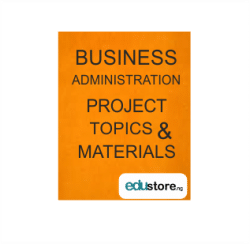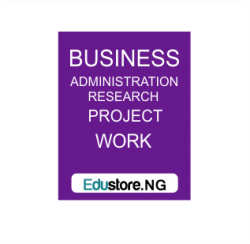ABSTRACT
The major purpose of this study was to determine if the nature of communication Enugu State Water Cooperation had a significant Influence on the workers morale and work performance.
It was also aimed at assessing the quality of communication within Enugu State water cooperation (ENSWC). Identifying the major channels / media of major barriers to effective communication.
The sample for the study include 100 respondents randomly selected from the three Directorates of the corporation. Data were collected by means of the communication within the organization.
The data were analyzed using percentages and correctional analysis. The following finding were obtained from the tudy.
1. The major channels of communication were formal, informal channels like the grapevine were rarely utilized.
2. The major media of communication were verbal and written. Verbal medium was accredited to be good and properly utilized, downward and upward communication appeared not to be good and properly utilized. Written media which include memos and letter were satisfactory but indicated that some improvement needed be made.
The major barriers to communication were found to be time pressure, sender, source credibility, information filtering and information overload.
CHAPTER ONE
INTRODUCTION
Improving employee performance and morale through effective communication which make a effective in his job. Managers in general and industrial psychologist have been sticking to improve worker effectiveness in his job. As noted by from (164:191) a substantial proportions of the research in this field has been concerned ,with explaining individual difference in job performance. Also many of the methods used by professional industrial psychologists are directed towards increasing the level of performance of workers. Certain factors have been widely recognized as having reasonable influence on the morals and performance of employee in industrial firms. Vom (1964:91) for instance stressed the importance of motivation.
Middle West and Hill (1988:3160 viewed communication between two or more people to achieve a common understanding about an object or a situation. The process of communication starts with the formation of ideas by the sender (know as ideation which is the content of the message the sender want to transmit. In the next step, encoding, the ideas are organized into a series of symbols designed to the intended receiver(s) suitable words or phrases that must be understood by the receiver(s) and the appropriate medium or media to be used memorandum, conference, etc were selected.
Next transmission of the message takes place as encoded through selected channels in the organization structure. In transmission the message is then received and then decoded, or changed in to the form to be understood by the receiver.
In the next step, the receiver takes action or responds by filling the information, asking for more information etc. Communication has not taken place unless there is some type of feedback to the sender in the message received.
Possible barriers exist to the communication process, and such barriers could exist in any stage of the communication process. These include poor reception poor listening semantics, Cultural difference and
Organizational climate etc.
(Sherman et al, 1998:322). These barriers sometimes referred to as noise, could be removed or reduced through adequate knowledge of then and concerted efforts at taking certain steps such as training for improved perceptual ability, proper non evaluative listening use of simple words, conciseness and specificity other include improving the organizational climate encouraging openness) sincerity on the part of management
DOWNLOAD COMPLETE WORK- For Reference Only: Materials are for research, citation, and idea generation purposes and not for submission as your original final year project work.
- Avoid Plagiarism: Do not copy or submit this content as your own project. Doing so may result in academic consequences.
- Use as a Framework: This complete project research material should guide the development of your own final year project work.
- Academic Access: This platform is designed to reduce the stress of visiting school libraries by providing easy access to research materials.
- Institutional Support: Tertiary institutions encourage the review of previous academic works such as journals and theses.
- Open Education: The site is maintained through paid subscriptions to continue offering open access educational resources.






